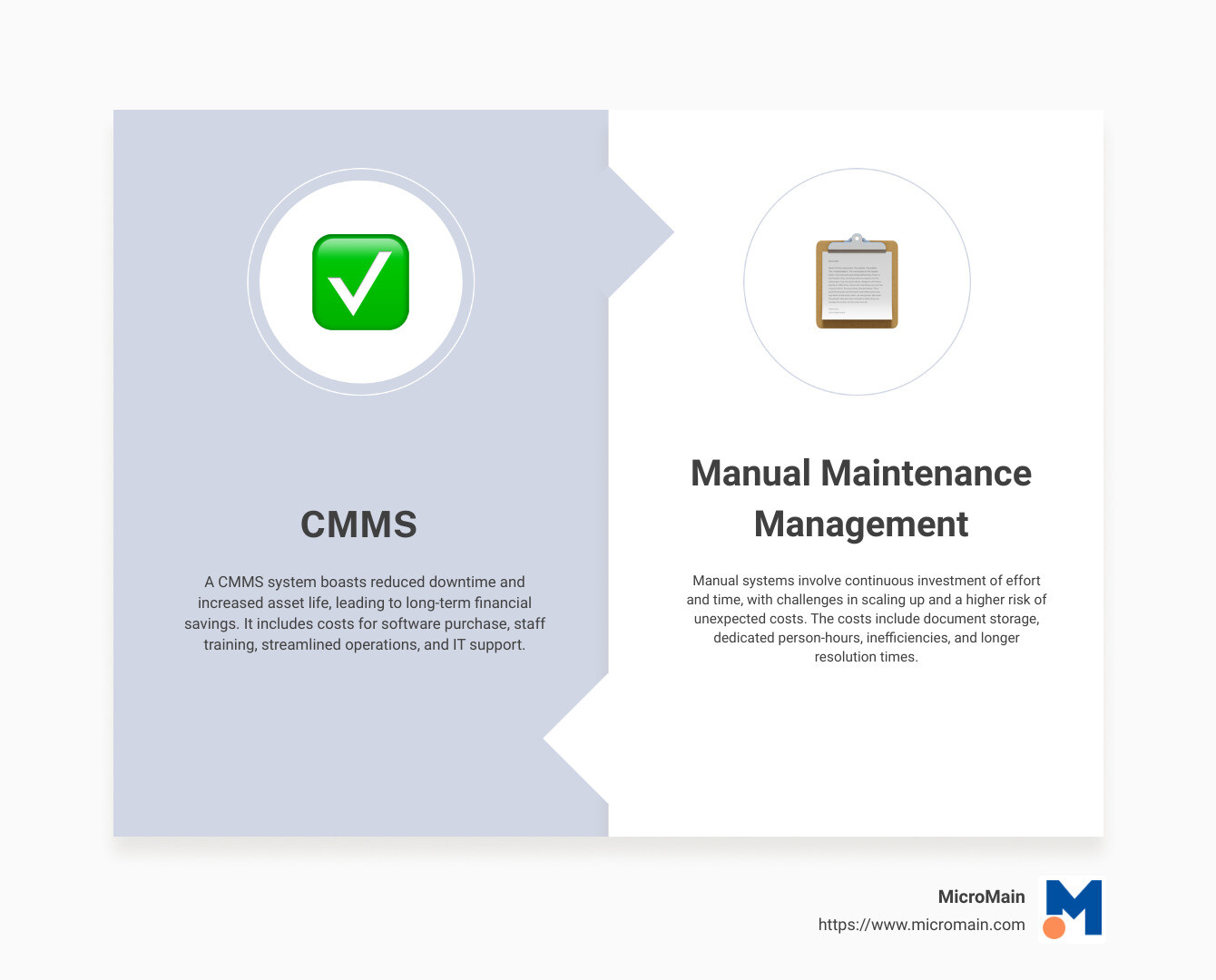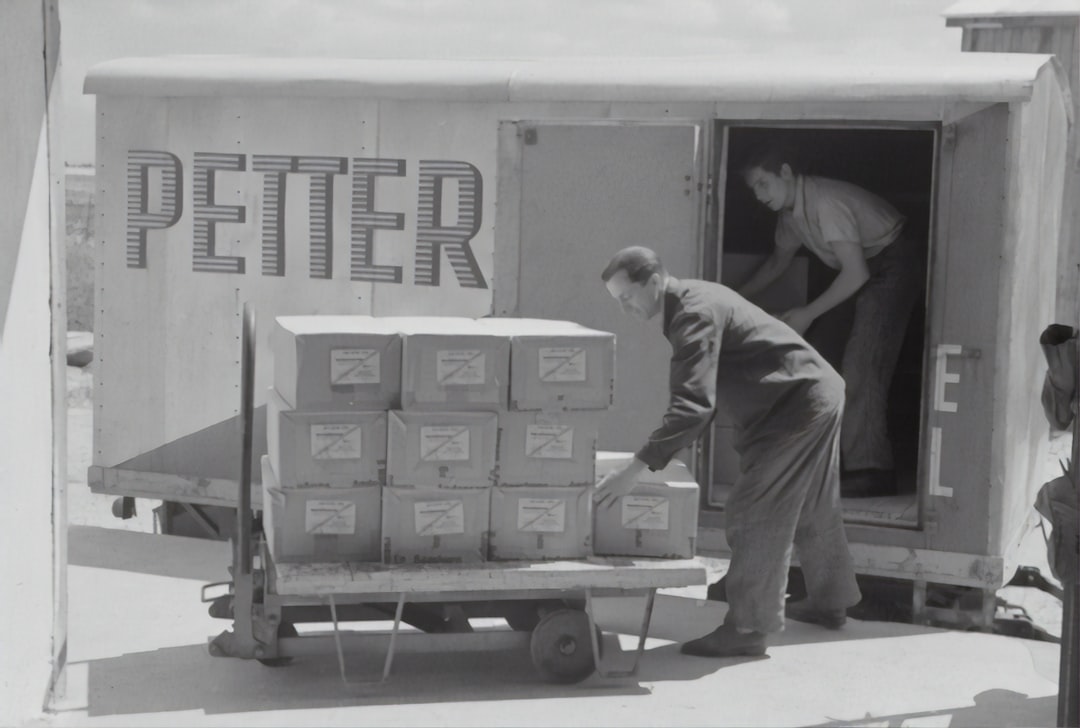Introduction
Are you burdened with mounting maintenance costs in your manufacturing plant? Agonizing over unplanned equipment downtime? You're certainly not alone. Manufacturing industries' struggle to balance operational efficiency and cost-effectiveness is genuine. One of the significant contributors to this problem—maintenance management—often leaves companies in flux, torn between the age-old manual processes and modern, technology-driven solutions. But have you considered the cost comparison between CMMS and manual maintenance management?
Brief Overview of CMMS and Manual Maintenance Management
Before delving into the cost comparison, let's briefly identify the two systems involved. CMMS, or Computerized Maintenance Management System, as the name suggests, is a software solution equipped to handle maintenance operations, including work order tracking, scheduling, inventory control, and much more, in a digitized fashion. This allows for centralized data access in real-time, automation of core functions, and overall enhancement in operational efficiency. Conversely, manual maintenance management relies on human-driven processes and physical documentation. It might offer control but often results in efficiency loss due to its lack of real-time data accessibility and automation.
Importance of Cost Comparison in Maintenance Management
Why is the cost comparison critical? It's simple. Every manufacturing business aims to minimize its operating costs and maximize efficiency. By comparing the costs of manual vs. CMMS, we can determine which system offers an optimal balance between expense and output, giving you the best value for your money.
Let's set the stage with quick data points:
- Initial Investment: CMMS involves purchasing software and staff training, while manual management requires physical document storage and dedicated person-hours.
- Operational Cost: CMMS comes with potential cost savings due to automated processes and streamlined operations but might include additional IT support costs. In contrast, manual systems can inflate costs due to inaccuracies, inefficiencies, and longer resolution times.
- Long-term Financial Impact: Effective CMMS deployment can result in significant long-term savings due to reduced downtime, fewer errors, and improved asset life. In contrast, manual systems require continuous investment in effort and time, with a higher risk of unexpected costs.
Here's a comprehensive look at the cost aspects of CMMS vs. manual maintenance management:
| Costs Involved | CMMS | Manual Maintenance Management |
|---|---|---|
| Initial Investment | Software Purchase, Staff Training | Document Storage, Dedicated Person-hours |
| Operational Costs | Streamlined Operations, IT Support | Inefficiencies, Longer Resolution Time |
| Long Term Impact | Reduced Downtime, Increased Asset Life | Continuous Time/Effort Investment, Unexpected Costs |

Understanding these cost aspects in detail will give businesses a more comprehensive backdrop to make the right maintenance management decision. We're all about giving you the best value for your money. Let's dive in deeper!
Understanding CMMS (Computerized Maintenance Management System)
Definition and Functionality of CMMS
A Computerized Maintenance Management System (CMMS) is a digital solution to manage and streamline maintenance operations. This powerful tool takes the burden of manual processes and centralizes tasks such as tracking inventory levels, scheduling preventive maintenance, generating comprehensive reports, and managing work orders. It's a significant leap from manual methods, allowing businesses to monitor and control maintenance activities in real-time, enhancing efficiency and reducing costs.
Benefits of CMMS in Manufacturing
Efficiency in Maintenance Operations
One of the most significant benefits of CMMS is its ability to maximize operational efficiency. It automates and organizes maintenance tasks, allowing teams to work smarter, not harder. For instance, a CMMS can monitor inventory levels, alerting when stock is low or parts need replacement. This prevents operational slowdowns due to a lack of necessary parts or materials, thereby enhancing the efficiency of maintenance teams.
Real-time Data Analysis and Reporting
A CMMS isn't just about managing tasks; it's also about extracting valuable insights from data. Our CMMS software provides detailed reports on maintenance operations, including labor costs, parts costs, exceedance rates, and emergency repairs. These reports can be generated quickly, allowing businesses to conduct real-time evaluations of their maintenance operations and make necessary adjustments to reduce costs and improve efficiency.
Scalability and Adaptability
Lastly, a CMMS is scalable and adaptable, two vital features for growing manufacturing companies. As your business expands, so too can your CMMS, ensuring that your maintenance management needs are met, regardless of the size or complexity of your operations. Moreover, the flexibility of a CMMS allows it to adapt to various industry needs and changes, ensuring that it remains a valuable tool in your maintenance management arsenal.
In conclusion, a CMMS provides a comprehensive and efficient solution for managing maintenance operations. It automates and streamlines tasks and provides valuable insights through real-time data analysis and reporting. Its scalability and adaptability make it a worthy investment for manufacturing companies of all sizes and sectors.
Understanding Manual Maintenance Management
Definition and Functionality of Manual Maintenance Management
As the name suggests, manual maintenance management is the traditional method of managing and overseeing maintenance operations without automated software. It includes scheduling maintenance tasks, tracking work orders, managing inventory, and keeping maintenance history records. All these activities are performed manually, often involving physical paperwork and labor.
Challenges of Manual Maintenance Management in Manufacturing
Difficulty in Scaling Operations
One of the significant challenges of manual maintenance management is its inability to scale efficiently as the business grows. As noted in our research, expanding business operations often means increasing the volume of maintenance tasks and data. This presents a significant challenge for manual systems, which require substantial physical resources such as storage space, filing cabinets, and manual labor. As a result, there is a risk of losing visibility into maintenance activities, which can increase the likelihood of equipment breakdowns and downtime.
Inefficiency and Delays
Manual maintenance management also introduces inefficiencies and delays in the maintenance process. For instance, manual data entry can be time-consuming and prone to errors, making it difficult to analyze data and identify trends for optimization. As such, businesses often must react to maintenance issues rather than proactively addressing them, leading to increased downtime and maintenance costs.
Lack of Real-time Data Analysis
Unlike a CMMS, manual maintenance management does not provide real-time visibility into maintenance activities. This lack of real-time data can hinder timely decision-making and prevent businesses from optimizing maintenance operations. Furthermore, manual record-keeping and reporting can be error-prone, leading to inaccuracies affecting the overall maintenance strategy.
In conclusion, while manual maintenance management may be suitable for smaller businesses with limited maintenance needs, it presents significant challenges for more prominent, growing manufacturing companies. The lack of scalability, inefficiency, and real-time data analysis can increase costs and lower efficiency. On the other hand, implementing a CMMS can help eliminate these challenges, providing an efficient, scalable, and data-driven solution for maintenance management. In the next section, we will delve deeper into a cost comparison of CMMS vs manual maintenance management to help you make an informed decision.
Cost Comparison: CMMS vs Manual Maintenance Management
When considering transitioning from manual maintenance management to a CMMS, it's essential to examine the costs of each approach closely. This includes setup costs, operational expenses, and long-term financial implications.
Initial Investment and Setup Costs
Cost of CMMS Software and Training
The initial cost of implementing a CMMS involves purchasing the software and training your staff. Depending on the vendor and the features required, the price of a CMMS can vary. For instance, the eMaint CMMS offers monthly plans from $69 per user, while other vendors may provide different pricing structures. In addition, training costs should also be factored in. While most vendors offer web-based training services for free, in-person training may require an extra fee.
Cost of Manual System Setup
In contrast, the setup costs for manual maintenance management are often lower but can still be significant. These can include expenses for paperwork, filing systems, and time spent developing and implementing manual processes.
Operational Costs
Cost of Running a CMMS System
Operational costs for a CMMS system are generally lower compared to manual systems. Through automated scheduling, work order tracking, and real-time data analysis, a CMMS can help streamline maintenance operations, resulting in cost savings from reduced failures and increased uptime.
Cost of Running a Manual Maintenance System
On the other hand, operational costs for manual systems can be high and difficult to control. These costs include time spent managing paperwork, inefficiencies due to lack of real-time data, and potential for errors in manual record-keeping.
Long-term Financial Implications
Return on Investment for CMMS
While the initial cost of a CMMS might be higher, the return on investment is often significant. By reducing equipment downtime, extending asset life, and improving efficiency, a CMMS can lead to substantial cost savings in the long run.
Long-term Costs of Manual Maintenance Management
In contrast, while the upfront costs of manual systems may be lower, the lack of efficiency and data-driven decision-making can lead to higher costs over time. From increased equipment downtime to inflated maintenance costs, manual systems can pose significant financial risks in the long term.
In conclusion, while both CMMS and manual maintenance management systems have their costs, the value provided by a CMMS in terms of efficiency, reduced downtime, and data-driven maintenance planning can lead to significant cost savings in the long run. As we say at MicroMain, investing in a CMMS streamlines your maintenance operations and positively impacts your bottom line.
The Role of EAM (Enterprise Asset Management) in Maintenance Management
Understanding EAM and its Relation to CMMS
Enterprise Asset Management (EAM) is a comprehensive system that focuses on the entire lifecycle of an asset, from design and purchase to retirement. Contrary to a CMMS, which focuses primarily on maintenance management, EAM takes a broader view, considering an asset's total cost of ownership (TCO).
Interestingly, EAM grew out of CMMS, acting as an extension rather than a replacement. The relationship between the two can be likened to a tree and its branches, with the CMMS forming the trunk (the base of your maintenance system) and the EAM acting as the branches that can more precisely track your operations.
Benefits of EAM in Maintenance Management
An EAM system offers numerous benefits for manufacturing companies. It can handle work orders, manage inventory, track costs, and generate reports like a CMMS. However, an EAM system also holds historical maintenance records of assets for better reporting and financial planning than a traditional CMMS.
In addition to preventive maintenance, EAM can venture into predictive maintenance, constantly monitoring machinery and how well they're operating. If machinery falls below pre-set operating conditions, an alert is sent to your EAM system, allowing maintenance to be scheduled efficiently and proactively.
Finally, EAM can focus better on the workflow of your technicians than a traditional CMMS system can. It considers more steps in your technician's process, making it easier to look through the data and determine what steps in your maintenance operations are working and which aren't.
Cost Implications of Integrating EAM with CMMS
Regarding the cost comparison of CMMS vs manual maintenance management, integrating EAM with CMMS might initially seem like an added expense. However, EAM can lead to significant cost savings in a longer-term perspective.
EAM's ability to handle historical maintenance records, predict maintenance needs, and focus on the workflow of technicians results in a more efficient maintenance schedule. This efficiency can drastically reduce downtime and extend asset life, saving costs.
Moreover, the comprehensive reporting EAM provides can help you make smarter, cost-effective decisions. By analyzing past data, you can justify new hires, stay on top of warranty information, and inventory spare parts effectively.
In conclusion, while integrating EAM with CMMS involves an initial investment, the long-term cost savings and operational benefits make it worthwhile for any manufacturing company looking to optimize its maintenance management. As we like to say at MicroMain, the goal is not just to manage your maintenance operations but to manage them as cost-effectively and efficiently as possible.
Making the Right Choice: Factors to Consider Beyond Cost
While cost comparison is crucial when deciding between CMMS and manual maintenance management, other considerations exist. The right choice for your business will also depend on other factors, such as the complexity of your machinery, the number of locations you're managing, your need for real-time data, and the potential for future growth.
Complexity of Machinery and Number of Locations
A CMMS can be invaluable if you're managing a large number of machinery or operating in multiple locations. Traditional manual maintenance management can be overwhelming when dealing with a high level of complexity or multiple sites. On the other hand, a CMMS can handle vast amounts of data and streamline operations, making it easier to manage complex machinery and multiple locations.
The goal is not just to manage your operations but to manage them as cost-effectively and efficiently as possible. MicroMain can provide a scalable solution that grows with your business, catering to both small operations and large enterprises.
Need for Real-time Data and Reporting
In the age of Industry 4.0 and the Internet of Things (IoT), real-time data and reporting are more important than ever. If your business requires real-time visibility into maintenance activities, a CMMS can provide that. It automates maintenance management processes, eliminates errors and delays, and provides insights into maintenance activities to optimize asset utilization.

While manual maintenance management can provide some data, it could be more time-consuming and prone to errors. MicroMain's CMMS gives you access to real-time data, analytics, and reports, enabling you to make data-driven decisions and optimize your maintenance cycles.
Scalability and Future Business Needs
Finally, it's essential to consider the potential for future growth. As Yogesh Choudhary, the CEO of FieldCircle, rightly states, "Scalability is not just about growth; it's like having a foundation that can effortlessly support the weight of innovation and expansion, allowing businesses to soar to new heights."
A CMMS can adapt and evolve quickly to meet changing needs and challenges. For instance, a CMMS can easily accommodate more users, equipment, and locations if your business plans to expand. Conversely, manual systems can become more challenging to manage as the business grows, leading to increased costs and inefficiency.
In conclusion, while cost is an essential factor, the decision between CMMS and manual maintenance management should also consider the complexity of machinery, the need for real-time data, and the potential for future growth. At MicroMain, we are committed to helping businesses make the right choice for their unique needs, providing them with powerful, flexible, and easy-to-use CMMS and EAM software.
Conclusion
Recap of Cost Comparison
As discussed throughout this article, the cost comparison between CMMS and manual maintenance management is about more than just the initial investment. It extends to the long-term operational costs, efficiencies gained, and the potential return on investment. In the short term, the expense of a CMMS system may be higher due to the cost of software, training, and implementation. However, when we shift our focus to the long-term, the benefits of a CMMS system like ours at MicroMain begin to shine.
With a CMMS, you can expect reduced downtime, improved asset lifespan, better inventory management, and significant savings on utility costs. These benefits add up to substantial long-term cost savings. On the other hand, while a manual system might have lower upfront costs, the long-term implications include higher operational costs, inefficiencies, delays, and a lack of real-time data analysis capabilities.
Final Thoughts on Choosing Between CMMS and Manual Maintenance Management
When choosing between CMMS and manual maintenance management, the decision should be more than just the immediate cost comparison. Instead, consider the long-term financial implications and each system's overall value to your company.
Ultimately, it's about finding a solution that provides the most value, enhances efficiency, and aligns with your company's future needs. A CMMS such as that offered by MicroMain does not just offer a software solution; it provides a roadmap for future-proofing your maintenance management.
While manual methods may seem cost-effective initially, remember that their limitations can lead to missed opportunities for optimization, reactive maintenance practices, and difficulty scaling your operations.
We believe in the potential of CMMS to revolutionize maintenance management practices, offering a comprehensive, scalable solution that grows with your business. But don't just take our word for it; explore the benefits of our CMMS for yourself.

The proper maintenance management software massively affects your business's productivity and profitability. Making the correct choice today will set the foundation for successful maintenance management.
For more insights on maintenance management, check out our resources on maintenance management solutions and the basics of CMMS.
 For immediate assistance, please call us at (512) 328-3235
For immediate assistance, please call us at (512) 328-3235




